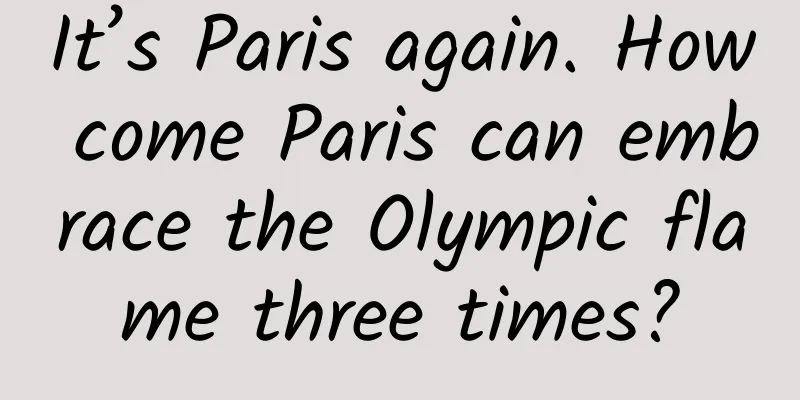It’s Paris again. How come Paris can embrace the Olympic flame three times?

|
In the hot summer, the 30th Olympic Games is in full swing. This is the second city in history, after London, to embrace the Olympic flame three times. Paris has a long history of Olympic love since the dawn of the modern Olympic Games in 1896. The Olympic Games have chosen Paris as the stage three times, which is not only a profound recognition of Paris's long history and cultural heritage, but also inseparable from its unique geographical location, excellent venues and facilities, and the city's unremitting efforts in transformation and innovation. 0 1Showing unique charm is groundbreaking The second modern Olympic Games held in Paris in 1900 was groundbreaking. Although the organization of this Olympic Games seemed chaotic, the competition lasted for more than five months (from May to October of that year), and was even jokingly called "an international competition for physical exercise and sports", it still laid an important foundation for the subsequent Olympic Games. At the meeting, 22 female athletes participated in various competitions, including two brave female croquet players, opening a new chapter for the development of women's sports. At the same time, football was introduced into the Olympics for the first time, providing a new stage for the development of international football. This event marked the development of the Olympics from the initial stage to the direction of standardization and institutionalization. A scene from the 1900 Paris Olympics Source: Olympic official website The 8th modern Olympic Games held in Paris in 1924 was a landmark event in Olympic history. This Olympic Games not only witnessed the birth of the Olympic Village, but also introduced the Olympic motto "Faster, Higher, Stronger" for the first time , adding more ceremonial sense to the Olympic Games. In particular, the establishment of the Olympic Village not only solved the accommodation problem of athletes, but also promoted exchanges and friendship among athletes, adding more humanistic color to the Olympic Games. The first Olympic Village in 1924 Source: Olympic official website A hundred years later, this great city entered the Olympic moment for the third time, and it still brought many "firsts": the first time there was no main Olympic stadium; the first time the opening ceremony was held outdoors; the first time a "carbon budget" was set up; the first time a purple running track was used; the first time a 1:1 ratio of male and female athletes was achieved; the first time men were allowed to participate in synchronized swimming competitions; the first time breakdancing was included in the Olympic events... Paris has also integrated competition venues into well-known landmarks and built a series of "city stadiums". Spectators can watch beach volleyball games at the foot of the Eiffel Tower, archery in the Invalides, fencing in the Grand Palais, and equestrian events in the Palace of Versailles. 0 2 Obvious geographical advantages and profound historical heritage Paris is located in the heart of the European continent and is an important transportation hub connecting Western Europe, Central Europe and Northern Europe. This geographical location allows Paris to easily radiate to surrounding countries and regions and become one of the centers of European economic, cultural and political activities. The city's history dates back to the Roman period in the 3rd century BC, when it was known as Lutetia. As history progressed, Paris gradually evolved from a military fortress to an important commercial center in the Middle Ages, and became the capital of the Kingdom of France in the 10th century. During this period, Paris built many iconic buildings, such as Notre Dame de Paris and the Palace of Versailles, laying the foundation for its cultural heritage. Entering the Renaissance and the Enlightenment, Paris' urban construction further developed and became the cultural and artistic center of Europe. The construction of the Palace of Versailles during the reign of Louis XIV marked the peak of the Baroque style here. In the 20th century, Paris' status as an art center was recognized worldwide, and Montmartre and the Left Bank attracted countless artists to create. At the same time, the completion of modern landmark buildings such as the Eiffel Tower and the Louvre's glass pyramid also demonstrated Paris's modernization process that keeps pace with the times. Poster of this Olympic Games Paris is known as the "art capital of the world" and has many cultural facilities such as museums, theaters, and concert halls. These facilities not only provide a stage for artists to showcase their talents, but also provide citizens and tourists with a wealth of cultural and entertainment activities. In this respect, participating in the Paris Olympics is actually a baptism of art. 0 3Rich site resources and active urban transformation From the iconic Stade de France, to the Roland Garros tennis stadium, to the Parc des Princes, and even to the elegant Place de la Concorde, each venue is not only a temple of sports competition, but also a perfect fusion of Parisian culture and modern style. These venues not only have amazing capacity and first-class equipment, but also have accumulated rich experience from hosting international competitions for many years, ensuring that every event meets the highest international standards. Opening ceremony of the 1924 Paris Olympics Source: Olympic official website In addition, every Olympic Games is a comprehensive upgrade of the city's infrastructure. From optimizing the city's transportation network, improving the efficiency and coverage of public transportation, to strengthening environmental protection measures, promoting green travel and sustainable development; from increasing accommodation facilities to ensure the comfort of tourists and athletes, to improving the level of urban services and creating a friendly and inclusive urban atmosphere, Paris has carried out in-depth and meticulous transformation in all aspects. 0 4 Prove its strength and celebrate the spirit of Paris Every time the Olympic flame is lit, it is a tribute to Paris's past glory and an expectation for the infinite possibilities of the future. Paris, the city that never ends, is continuing to write its indissoluble bond with the Olympics in its own unique way, and moving towards a more glorious tomorrow. Author: Wei Deyong, member of Shenzhen Writers Association, Guangdong Editor: Dong Xiaoxian |
<<: From weed to staple food, the 10,000-year history of China's rice counterattack
Recommend
Black Widow withdrawn from theaters, release date to be determined, originally planned to be released in North America on May 1
Original title: Due to the epidemic, "Black ...
Activity planning plan (with mind map)
Planning is a field that requires thinking talent...
The world has begun researching 6G, 100G/s! Deployment will begin in 2030
[[265644]] According to the 21st Century Business...
Weekly SEM introductory course
Chapter 1: Introduction to SEM account opening an...
Putting aside vanity metrics, how do you plan a successful new customer acquisition campaign?
Attracting new customers has always been the goal...
13 case studies teach you 3 tricks to achieve 0-budget planning of a million-PV event
In a startup company, both personnel and support ...
How do scientists "see through" the "true identity" of the virus? Extreme Speed Electronics gives humans "wisdom eyes"!
There are many diseases that are caused by viruse...
How does language strangely affect our perception of time and space?
© Film Music Central Leviathan Press: Have you ev...
User Activation Methodology of AARRR Model
What is the AARRR model ? The AARRR model is also...
The most comprehensive guide to promoting good products on Zhihu
There is a very good question on Zhihu: Why do or...
Scientists have discovered that there may be a reason why "one pregnancy makes a woman stupid for three years"
I believe everyone has heard the saying "pre...
Radio signals in a storm: riding the wave or hanging by a thread?
With thunder and lightning, howling winds, and po...
Why is the effect of information flow advertising worse after targeted advertising?
We all know that the first step in doing informat...
Profitable! Konka, once the king of Chinese color TV, fired the first shot of the Jedi counterattack in China's color TV industry
At a time when the Chinese color TV industry was ...
This custom is actually "taking poison"! Stop it now!
Audit expert: Wang Guoyi Postdoctoral fellow in N...









